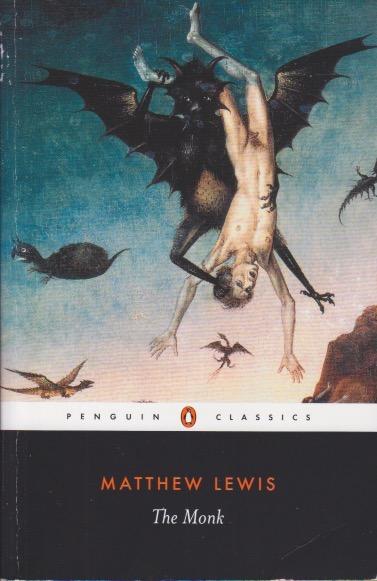
One of the strange things about gothic fiction is that, although often set on the continent, the early practitioners—inventors, if you will—were English. Three names among them stand out in many treatments of the genre: Horace Walpole, Ann Radcliffe, and Matthew Lewis. I’ve read the former two and have long supposed I should read the latter’s The Monk. This 1796 novel made the author famous, but it is long. And written in the often florid style of the age. Still, there are plenty of swoons and thunder-plagued nights. Set in Madrid with a cast of closely related characters, the novel has a twist ending that I did not see coming, which is pretty amazing considering that the book has been out for over two centuries. (I may have read about the ending before, but had forgotten, if that was the case.)
The novel intertwines two stories that revolve around Antonio, the eponymous monk. A paragon of righteousness, he heads an abbey in Spain and all are in awe of his piety. Until sex breaks through his vanity (so we are told; his piety was based on too high a self-regard). Once seduced, he can no longer maintain his status as chaste, and this sets in motion a tragedy that will leave innocent people dead and lives ruined. Lewis, it’s famously known, used the novel to critique excesses of the church. Its power, the novel demonstrates, corrupts. Still, at the end I was left feeling sorry for Antonio. He was set up by the Devil and his chances of winning were quite slim from the beginning.
Although PG-13 by today’s standards, the novel scandalized English society when it came out. The sex scenes were too explicit for the day, especially since they involved the clergy. The story has quite a leisurely layout, and only after 200 pages (in the edition I read) does the supernatural enter the picture. Once it does the pace begins to pick up. The weird thing is, despite its length, this story works. It’s considered a classic—although often dismissed because gothic literature generally is—it nevertheless delivers. Antonio is shown to be subject to weakness, and while vain, not inherently evil. He’s a victim of human vulnerability. Readers in the late eighteenth century couldn’t see beyond the sex, but there is a tragic human story here. Castles, abbeys, ghosts, and subterranean passages, murder and torture, it’s gothic through and through. Although it took most of September to get through it, it feels like I accomplished something worthwhile. And I finished just in time for Banned Book Week.
